Menu
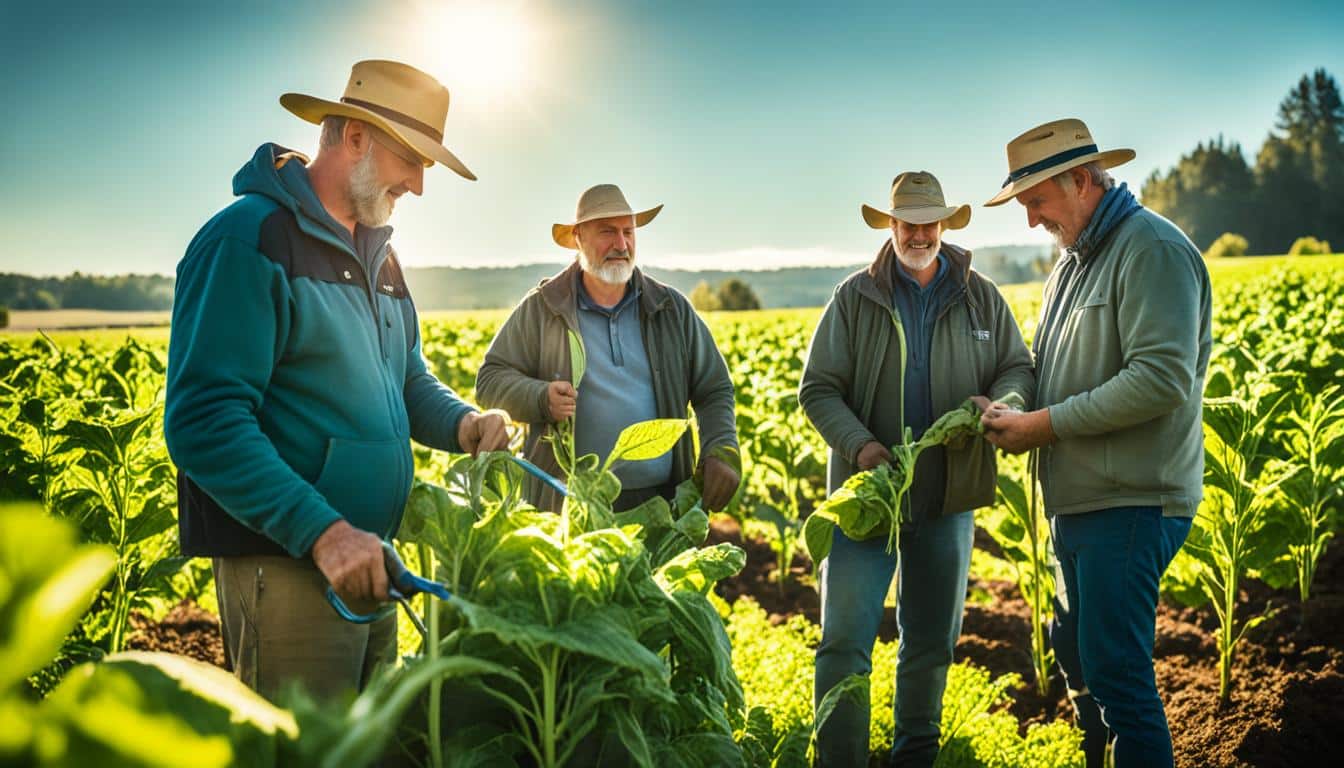
Did you know that one-third of global greenhouse gas emissions come from our food systems? This info comes from a study by the UN in Nature Food. To combat this, we need to focus on more sustainable ways of producing food. Collaborative farming is a step in this direction. It uses regenerative agriculture to heal the land and capture carbon, holding up to 20 tons per acre annually.
Climate change is making it harder to grow food. Rising temperatures and extreme weather are reducing crop yields and forcing us to move farming areas. The key is to change how we farm. Regenerative agriculture boosts our ability to bounce back from difficulties. It also fits into a sustainable food system to keep food production stable.
Moving to regenerative farming takes time, about three to five years for most crops. But, it brings us more reliable and bigger harvests. It also cuts costs and makes farmers more money. This change needs everyone in the food chain to work together. By investing in these methods, sharing resources, and supporting farmers, we can improve how secure our food is.
Sysco’s support for farmers is one good example. They help finance and give tools to those using regenerative techniques. Their work shows how businesses in food can make a big, positive difference in our food systems.
Collaborative farming, known as farm co-ops or agricultural cooperatives, helps create a sustainable and fair farming sector. Through an agriculture partnership, farmers work together. They share what they know and their resources to benefit each other. This approach lets them share skills, work, tools, land, money, and other key things. It makes the community’s food supply stronger.
In this farming type, farmers use things like buildings and tools together. They also share farming networks, ways to sell their products, and help systems. By doing this, they can use regenerative agriculture techniques. These methods help land to heal and farming to last longer.
But it’s also important to know the problems that can happen. Sometimes, people might not get along or agree on how to share the rewards. There could be problems if someone works less or if their ways of farming or selling things are different. Even with these challenges, working in a planned way in an agriculture partnership helps solve many problems. This makes sure the effort is still worth it.
There are many ways farms can work together. They can be as simple as friends helping each other, or as complex as a formal business. Some farms are there to help new farmers. They provide land and advice, helping the whole community grow.
This support sounds good, but it doesn’t come without its own share of issues. Environmental problems or troubles amongst the people can happen. Farmers thinking of joining need to weigh up the good and the bad. It’s crucial to pick an option that fits what you need and want to achieve.
Over 2 million American farmers are now part of collaborative farming. This shows a big move towards fairer and more eco-friendly food systems. Working together makes the food supply smoother and stronger. It also supports efforts to improve food access for everyone, both locally and worldwide.
I believe making sure everyone has enough food is key for the planet’s food to keep growing. This challenge is affected by many big and small problems everywhere. To solve it, we need to look at the world as a whole and the special issues each place faces.
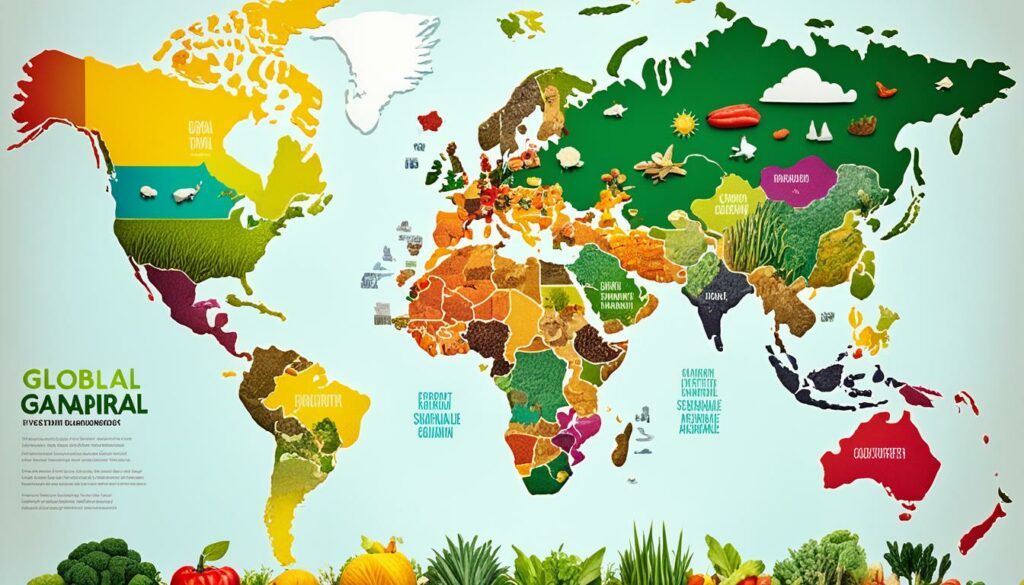
Making food on a large scale is not easy. Almost half of our suitable land and most of our fresh water are used in farming. But, still, 828 million people don’t get enough to eat, and up to 2.4 billion people find it hard to have food. This is happening while over a billion people are too heavy, showing we’ve got a big problem to solve. In the future, our world’s population will grow to 10 billion by 2050. So, we really need to change how we produce and distribute food.
Throwing food away is a big issue, with about a third of all food worldwide being wasted. This not only loses a lot of resources but also makes the problem of not having enough food worse. There are new technologies, like aseptic packaging, that can help. This packaging lets food sit at room temperature for up to six months without spoiling. Aseptic cartons are mostly recyclable, showing how we can make the process of producing food better for the planet too.
In local areas, food security issues are very hard-hitting. Problems like chain supply breaks, prices that keep changing, and bad weather affecting crops are common. About 75% of people facing poverty in poorer countries live in the countryside. They depend a lot on their local farming for their lives and to eat.
Farmers working together can get through the tough times better. By sharing their resources and what they know, they can be stronger against climate problems. For example, a way of farming called the Dairy Hub Model has boosted how much and how good the milk is from small farms. This makes the community more able to get through times when food production drops.
To solve the global food problem, we need to look at the bigger picture. Things like unfair trade, wars, lack of safety, and changing what we use land for are part of the issue. Working together in farming is a key way to improve. It helps fight the large obstacles to feeding everyone while making communities stronger against the effects of climate change.
Collaborative farming offers big gains in agriculture. It helps farmers in economic, social, and green ways. This approach supports better and more competitive farming.
Working together, farmers can see many economic boons. They enjoy better financial health and more profit by sharing resources. By joining forces on costs, they can improve their farm’s equipment and technology. This boost helps them produce more and compete better in big markets.
Noteworthy Features Include:
Farming partnerships also enhance the social scene. They create strong farming communities. These groups invest their profits back locally, improving services and projects. This move boosts everyone’s quality of life, especially in areas often overlooked by big farming companies.
Key Social Benefits:
The green benefits are huge. By putting their heads together, farmers can help the planet. They use practices that are good for the land. This includes things like rotating crops, planting cover crops, and not tilling as much. Such farming not only helps the planet but also creates a good place for new farmers to start.
This way, farmers can fight climate change as a group. They share new ideas to cut down on how much they affect the environment.
Environmental Gains Include:
| Benefit | Description |
|---|---|
| Regenerative Practices | Encourages the use of sustainable methods to restore land productivity and biodiversity. |
| Carbon Sequestration | Effective implementation of methods that capture and store atmospheric carbon in the soil. |
| Shared Knowledge | Exchange of best practices and innovative techniques among farmers. |
Collaborative farming is a key to facing global challenges today. It helps make the most of shared resources and reduces waste. This way, it’s good for the planet and makes farming more efficient.
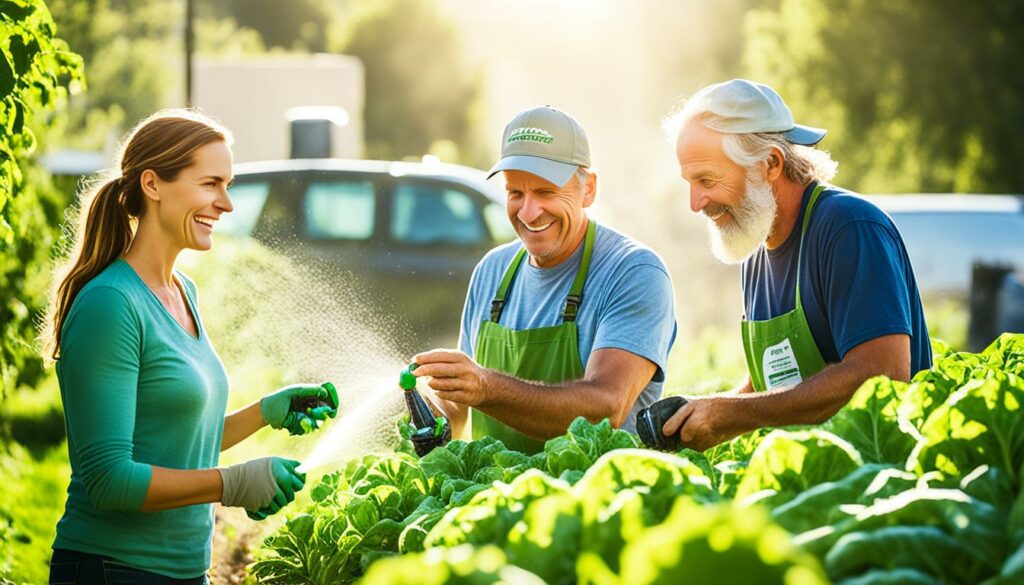
Shared resources are at the heart of joint farming. This includes equipment, knowledge, and access to markets. It helps farmers act together, saving money and improving what they grow.
For example, using regenerative farming can help the environment a lot. It can store up to 20 tons of carbon for every acre each year. Plus, farms using these practices often do better and spend less. This makes farming a win-win for farmers and the planet.
Also, companies like Sysco are making it easier for farmers to use these methods. They offer help with learning and money, showing how to farm smarter and cleaner.
Working together also cuts down on waste. Farms share their resources well and use what they have wisely. This means less is thrown away, which is good for everyone.
By sharing knowledge and technology worldwide, we can all farm better. One example is the OBOR project. It helps different countries use their resources smarter. This way, we can all have enough food in a way that’s better for our planet.
By working together and not wasting, farming can be a force for good. It can feed us all while keeping our earth healthy.
Looking at successful joint farming schemes gives us key lessons. They show us how effective and big they can get. When we dive deep into what works, we see that strong organisation and management play a huge role. Getting the inside setup right early can make a big difference later on.
The US has seen many benefits from working together in farming. For example, Florida’s Natural and Land O’Lakes have built powerful and tough farming systems. They do this by working together, boosting their social ties, and getting stronger negotiation power. This lets cooperatives in the US do more in agriculture.
Internationally, farming partnerships shine a light on the power of teamwork. From the EU, case studies highlight seven big influences on how well cooperative farming works. A look at 30 different local and regional groups points out another key thing. It shows that what matters most in the long run is how things develop, not how they start. All around the world, joining forces has improved efficiency, shared knowledge, and learning together, showing us the wide-reaching gains of these collaborations.
| Region | Organisation | Success Factors |
|---|---|---|
| United States | Florida’s Natural | Resource pooling, increased social capital |
| United States | Land O’Lakes | Joint investments, negotiation power |
| EU | Various Local Groups | Internal management, adaptive conditions |
| Global | Multiple Cooperatives | Efficiency, knowledge sharing |
Cooperative companies heavily affect modern farming. They form strong networks which help manage risks and improve financial security. They also make farmers stronger both in society and the economy. These groups do more than just make money. They help include more people socially and keep our food supply safe.
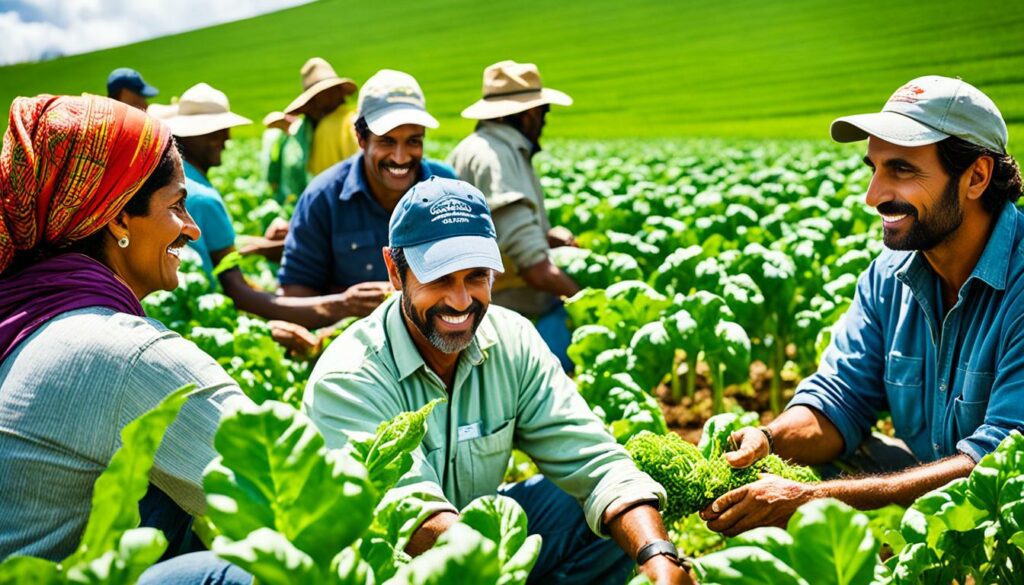
Major groups in farming, like the National Council of Farmer Cooperatives (NCFC) and the International Co-operative Alliance (ICA), push for cooperative ways. They offer farmers vital help, tools, and ways to work together. This support lets farmers deal with market issues better and work as a big group.
The FAO works to better support farming and food systems through investing smartly. Core farming co-ops create a friendly space where farmers can try new ways and solve problems.
| Organisation | Role | Impact |
|---|---|---|
| National Council of Farmer Cooperatives (NCFC) | Speaks up for U.S. farmers in policy and markets | Gives U.S. farmers power and wider markets |
| International Co-operative Alliance (ICA) | Pushes cooperative ways around the world | Helps everyone join in, grow financially, and sustainably |
So, these cooperatives are like the backbone of farming. They make it more productive and help keep it a good way to earn a living. They’re key in facing risks and problems to make farming and eating better for all.
Technological advancements are changing the game in collaborative farming. They boost efficiency and resilience. This shift promotes sustainability and the smarter use of resources. Among the leading technologies is precision agriculture.
Precision agriculture is changing how we farm by providing accurate, real-time information. It helps farmers make smart choices, reducing waste and improving results. An example is in California, where smart irrigation boosted yields by 15%.
In the Midwest, using precision seeding increased corn harvests by 12%. These technologies clearly work well, improving farming’s efficiency.
Indoor and vertical farming offer year-round growing conditions. They need less land and fewer pesticides, supporting biodiversity. In Washington State, automated nutrients increased apple production by 10%.
Vertical farming is especially efficient, needing less space to grow more food. This all helps meet the growing demand for more food in the future.
The rise of these farming methods is changing agriculture. Now, we’re using augmented reality, AI for weather forecasts, and the internet of things. These tools help us tackle climate change and food security, improving crop yields up to 70%. They’re key to a sustainable, efficient farming future.
| Technology | Advantages | Examples |
|---|---|---|
| Precision Agriculture Technologies | Increased efficiency, real-time data | Smart irrigation systems, precision seeding |
| Vertical and Indoor Farming | Space optimisation, year-round production | Automated nutrient management, climate control |
| Augmented Reality | Enhanced decision-making, training | Farm management simulations |
| Artificial Intelligence | Predictive analytics, optimised logistics | Weather prediction, crop health monitoring |
| Internet of Things | Connected devices, real-time monitoring | Smart sensors, automated systems |
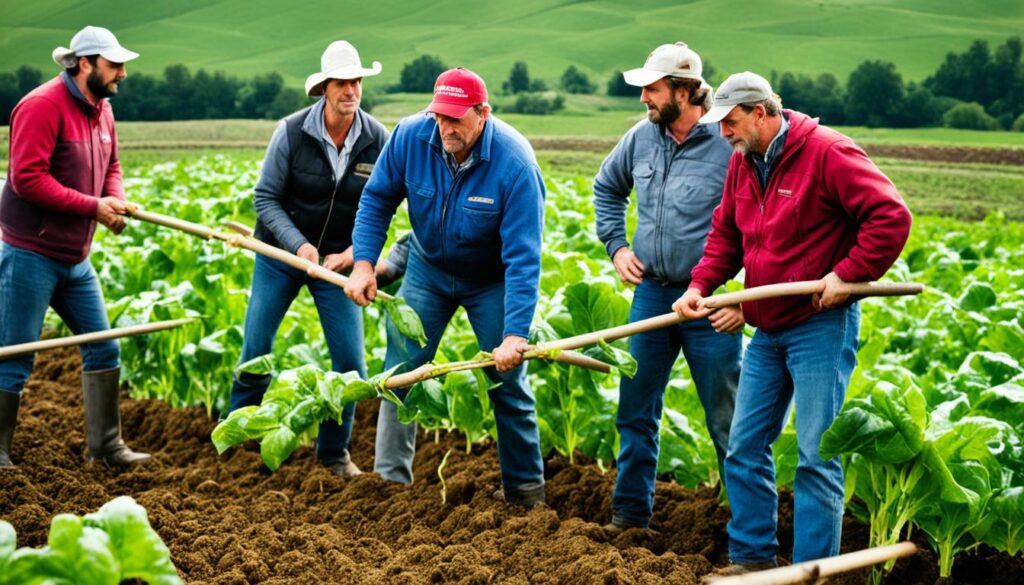
Collaborative farming helps share resources like skills, equipment, and land for a common good. Despite its benefits, it faces several challenges. Problems such as disputes, sharing profits, conflicts, and unfair resource distribution are common.
Farm collaborations come in many types, from simple agreements with neighbours to more complex structures. These include lease agreements, and cooperatives. All face their unique obstacles, which must be tackled for success.
Incubator farms aid new farmers by giving them land, tools, and advice. This helps overcome issues like not enough money to start or finding the right market. Yet, limitations in controlling soil quality and location are drawbacks.
One big challenge is forming strong partnerships with a variety of people in food security efforts. This includes farmers, policymakers, and researchers. Engaging with these groups is crucial for sustainable farming and creating new, smart solutions.
Good partnerships lead to better use of resources, more innovations, and stronger support for good policies. When local communities get involved, they take ownership of their food future. This boosts sustainable farming practices.
Overcoming challenges in collaborative farming needs a team effort and the right support. Providing education, resources, and fair policies is key. With these in place, collaborative farming can grow successfully without affecting food prices.
To promote collaborative farming, we need to involve many people. This includes farmers, policymakers, researchers, and local groups. By working together, we can find lasting solutions that make food more secure for everyone. This approach leads to new, open, and effective ways to deal with the issue.
Building strong partnerships is key to solving food security. Teaming up with government, non-profits, and businesses brings more resources and ideas. It also helps make better policies and a bigger impact together. These partnerships focus on sharing ideas, finding common ground, and creating benefits for all involved, making sure everyone has a fair say.
Getting communities involved is very important too. Talking openly with locals and letting them take the lead helps ensure everyone is included. It’s a way to hear their views and make sure our plans work for them. This makes our solutions stronger and more fair.
For better food security, we must also take care of our resources. This means saving water, looking after the soil, and using energy wisely. These steps help farming to be sustainable, which means we can keep producing food for the long run. Some methods, like regenerative farming, can even make the land healthier by taking in a lot of carbon.
Making the switch to this kind of farming might take a few years. But it pays off with more crops, less costs, and steady results. A company called Sysco is a great example of success through working together. They help connect farmers with what they need, including money for learning new farming methods.
| Key Strategies | Expected Outcomes |
|---|---|
| Engaging Stakeholders Across the Food Value Chain | Innovative, Inclusive, and Collaborative Solutions |
| Building Effective Partnerships | Mobilised Resources, Increased Innovation, Improved Policy Advocacy |
| Encouraging Community Participation | Enhanced Inclusivity, Effective and Equitable Solutions |
| Adopting Resource Management Practices | Better Water Conservation, Soil Health, Energy Efficiency |
| Transitioning to Regenerative Practices | Higher Yields, Cost Efficiency, Consistent Outputs |
In the end, working together and forming strong partnerships are vital for better farming and food safety. By including everyone, supporting local efforts, and taking care of our resources, we can build a strong food system for all. It’s about making our future food secure for generations.
Policies and rules help collaborative farming to grow. For example, the historic Capper-Volstead Act lets farmers work together to process and sell their crops. This way, they can make more food, more efficiently. Also, it makes food markets work better, helping us all get the food we need.
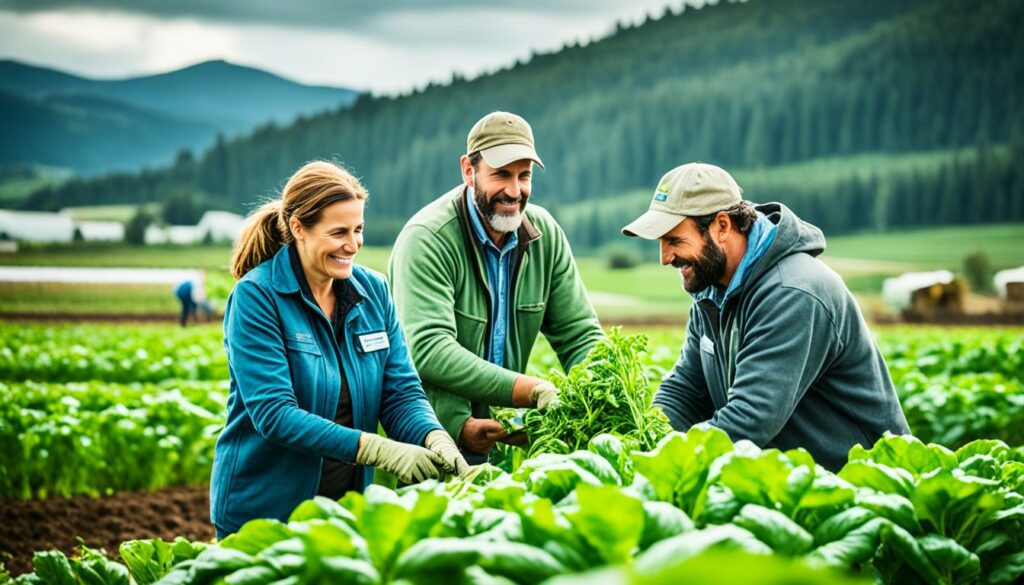
Government support is key for farming groups. The USDA’s RCDG, for instance, offers money to help rural areas. With this help, farmers can work together, save money, and make their farms better.
Global deals like the Paris Agreement and the UN’s SDGs show a big promise to farm together. They ask countries to make rules for farming that help the planet and feed everyone. By following these deals, nations can work together against hunger and climate change worldwide.
Informal ways of working together are also important. The Copake Agricultural Center is a good example. It shows that you don’t always need a big, formal plan to share and save costs. This helps small farmers a lot.
| Programme/Initiative | Key Features | Impact |
|---|---|---|
| Capper-Volstead Act | Legal framework for farmer cooperatives | Facilitates lawful collaboration and market access |
| Rural Cooperative Development Grant | Financial support for cooperative development | Enhances rural economic conditions |
| Paris Agreement | Global climate action framework | Encourages sustainable farming practices |
| Sustainable Development Goals | Comprehensive global objectives | Promotes agricultural collaboration for food security |
These methods, along with government help, build a strong foundation for farming. With these in place, farmers can unite towards a better, sustainable food future.
Collaborative farming stands at the core of developing sustainable food systems. It uses a collective approach in agriculture sustainability. Farmers combine resources and knowledge, which boosts productivity. It also helps protect our environment.
Sustainable farm practices like crop rotation and integrated pest management are key. They lead to better harvests without harming the land. This approach supports soil health and water conservation. It also helps cut down on the effects of climate change.
Sustainable farming is good for the economy of both places and countries. It lowers costs and widens market reach, making agricultural goods better. Small farmers are essential for ensuring there’s enough food. They use sustainable methods to strengthen local food supplies.
To fix the global food situation, everyone must work together. This includes policymakers, donors, and banking experts. Together, they can push for safer food through sustainable farming. This change can make farming better at capturing carbon. Also, it could lead to crops that are more profitable with fewer resources.
Working together in collaborative farming shows how to use resources better in food systems. By adopting regenerative farming, we make our food systems more resilient. We protect them against the effects of climate change. As a team, our effort in agriculture sustainability is vital for a stable, fair, and lasting food network.
The world of collaborative farming is changing fast. It’s adapting to meet the demands of tomorrow and using new ideas. With the goal of feeding 10 billion people by 2050 in mind, farming is heading in new directions.
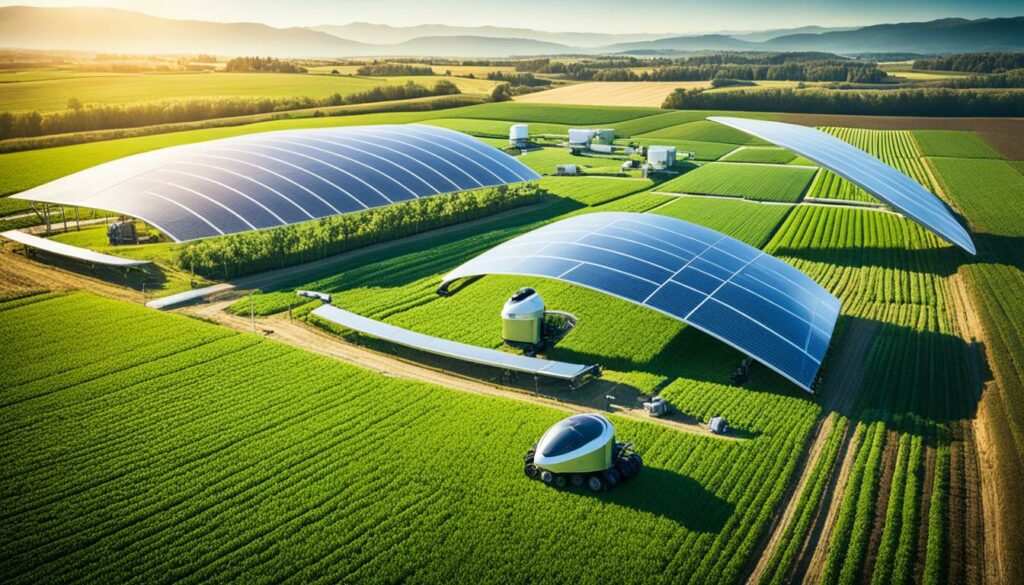
Farmers are growing different crops to meet various needs. This change makes food supplies more reliable and helps farmers earn steady incomes. Also, farming closer to where food is needed is picking up. This reduces pollution from transportation and keeps food fresher, supporting trends in collective farming.
Using high-tech tools is key in today’s farms. These technologies let farmers use water and fertilisers more wisely, cutting waste. More farms using these tools could mean more productive and eco-friendly farming in the future.
A big step forward is the Regenerative Innovation Portfolio. It has €30 million, supported by groups like Diageo. This project brings together over 25 groups to fight climate change in farming. It shows how working together can make big changes, improving the land and the air.
Another focus is cutting down on food waste. This effort will touch every part of getting food to us. It’s about saving our planet’s resources and making farm systems better for the long haul.
In all, farming’s future balances on technology, teamwork, and a green promise. With new ways to grow food and care for our planet, we’re on the path to a stronger, greener food supply.
| Trends | Impact | Examples |
|---|---|---|
| Diversification of Produce | Enhances food security and income stability | Implementing crop rotation and mixed cropping systems |
| Localisation of Farming | Reduces transportation emissions, improves freshness | Community-supported agriculture (CSA) programs |
| Technological Integration | Optimises resource use, increases yields | Precision farming tools and data analytics |
| Regenerative Practices | Restores ecosystems, reduces carbon footprint | Regenerative Innovation Portfolio |
| Waste Reduction | Conserves resources, enhances sustainability | Farm-to-table initiatives |
In summary, working together in farming greatly boosts global food security. It deals with the problems from climate change and old farming ways. Many have found that food security needs help from various people like farmers, scholars, leaders, and the public.
Dr. Jane Anderson believes that communities should help decide what to do. This makes the plans fit in with local culture and last longer. Important groups like the government, charities, and businesses must work together. They can get more resources, be more creative, talk about policies better, and handle food security issues.
141 studies show that working together in complex ways is key. They found 34 issues and 17 solutions linked to food security. Stopping food waste is a big deal. Reports show more people are hungry. This makes it urgent to act now. Around 20% of less developed countries can’t meet their people’s basic food needs. So, we must build a food system that can last.
In wrapping up, it’s plain that sharing wisdom and using resources better are critical. Saving water in farming is very important too. This approach supports the planet, communities, and the economy. Through this, farming can become more robust and secure for the future.
Collaborative farming uses resources better and increases income. It helps communities work together in farming and deals with land damage. This is caused by the changing climate and makes food easier to get.
Collaborative farming is when farmers work together, sharing their resources and knowledge. It helps everyone involved make more money and decide things together. It also funnels earnings back into the local area, helping it grow.
Having enough safe, healthy food is key for everyone’s well-being and peace. It’s critical, especially with climate change threatening what we grow and how we distribute food. This can lead to unstable prices and economic problems.
Working together means less individual spending on tools and resources. This boosts earnings and stability. Plus, it helps the local economy by keeping the money close and makes farmers more competitive.
Collaborative farming creates a stronger community feeling and improves life quality. It also brings essential products to areas big businesses might miss. And it supports farmers in times of need through its network.
This type of farming helps the land heal and promotes more plant and animal variety. It’s about farming smartly and wasting less. This makes our food system stronger and healthier for the planet.
By sharing tools and knowledge, less goes to waste. This method of farming makes sure we use what we have wisely. It’s all about working together for better, less wasteful farming.
Cooperative farms such as Florida’s Natural and Land O’Lakes show how working together is beneficial. Around the globe, cooperatives prove this model works in different farming settings, too.
Big groups like the National Council of Farmer Cooperatives work to help and promote this way of farming. They offer resources and a place for farmers to join forces. They also stand up for farmers’ needs.
New farming tech like precision and indoor farming help make farming together more efficient and less harmful to the planet. This makes food production smarter and more earth-friendly.
Making the switch to working together isn’t always easy. There are concerns about how much food and money it will bring. It takes time and effort to adapt to this approach and make it work for everyone.
Encouraging all parts of the food chain to come together and work towards the same goals helps. So does sharing knowledge and rewarding efforts to farm in smart, earth-centric ways.
Laws like the Capper-Volstead Act allow farmers to join forces without breaking the rules. Global agreements and goals set a path for making farming more sustainable and feeding the world safely.
By combining efforts and resources, this type of farming uses the earth better and strengthens local food economies. It helps make a food network that’s fair, balanced, and prepared for the future.
Experts foresee a big push towards more diverse, local, and tech-savvy farming. With support from policies and a growing understanding of the importance of food security, this trend is expected to flourish.